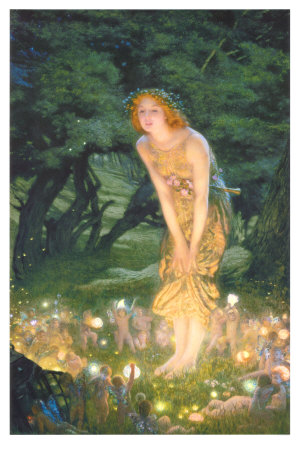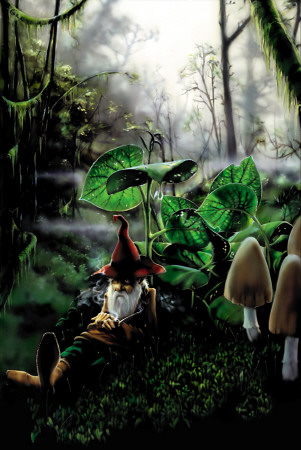
Elves, Brownies, Leprechauns and Other Legendary Beings
The Faery Folk of the British Isles include a wide assortment of beings. Hobs, boggards, elves, piskies and brownies are but a few of the unusual creature based on ancient legends.
By Terry McNamee © 2013... Do you have gnomes in your garden, or a hob hiding in your basement? Folklore is full of “wee folk” that may not be real except in children's imaginations. While legends of the Little People or the Faery Folk are found all over the world, they are especially common in England, Ireland, Scotland and Wales.
The Fae of the British Isles
In the British Isles, the history of the Little People dates back thousands of years. Often they are grouped together as Elementals, Fae, or fairy (faery) folk, and referred to as the Good People to help protect humans from their wrath, which could be quite malicious. Whether some or all were, or are, based on real beings is a question that has been debated for hundreds of years. The arrival of the Christian Church around A.D. 200 led to these old beliefs being denounced by priests as heathen, pagan or otherwise undesirable, but an undercurrent of belief in the Fae has remained to this day.
The Wee Folk of the British Isles include a wide variety of faeries, including but not limited to elves, pixies, gnomes, brownies, sprites, leprechauns, boggarts and hobs. Unlike supernatural creatures like werewolves or vampires, the Faery Folk were never human. They are often called preternatural beings, meaning they are unusual or outside the norm. The Fae all have a generally human-like appearance — they all walk upright, have hands instead of paws, have a spoken language, wear clothing, love music and so on — but they are not human, and only elves are thought to be able to interbreed with humans. Some Fairy Folk, like leprechauns, hobs, dwarves and gnomes, looked much like very small people, but others, such as pixies, sprites and imps, had a distinctly alien appearance, with large eyes, pointed ears and even wings. Some were believed to live very long lives or even be immortal, dying only if struck down by injury or illness.
Traditionally, some Fae avoided people, while others lived in close proximity with them. Some of the Wee Folk were helpful, but often they were fond of practical jokes and causing trouble. Many of the Fae preferred to go about their business without interacting with people, and most could be quite nasty if they felt they had been wronged. There are tales of them souring milk, causing crops to fail and moving, stealing or breaking items in retaliation for being slighted, insulted or harmed. A few were always dangerous and best left alone.
Elves are found in many cultures. In some, they are tall, ethereal beings, while in others they are very small. Over the centuries, the words elf and fairy have become used as generic names for various small preternatural beings, but elves are generally seen as a separate species of Fae. In Ireland, elves were described as tall and fair, much like (or even part of) the Tuatha de Danann, an ancient race of demi-gods which possibly were based on the actual proto-Celtic people known as Gaels who arrived in Ireland some 4,000 years ago. The Tuatha de Danann were tall and generally fair-haired. Elves could be benign or malevolent, but were not to be interfered with. They were often seen as an ancient race of beings of great power and the leaders of the Fae.
Other Types of Wee Folk
Leprechauns are the best known of the Irish Fae. The tales of these small men have followed the Irish as they emigrated to other lands such as Canada, the United States and Australia. They were about two to three feet tall, solitary, unfriendly and aloof. They could be found by following the sound of the tiny hammers they use to make shoes for faery folk. If caught, they would promise treasure (or, in some cases, three wishes) in return for being released, but these tricky faeries would vanish as soon as you looked away. In the old tales, they wore red coats. They knew and guarded the locations of the wealth of the Fae and of treasure troves left behind by the Danes who invaded Ireland centuries ago. Real or not, leprechauns are legally protected in a preserve in the area surrounding the medieval village of Carlingford, County Louth, Ireland, where some believe the last leprechauns in Ireland still live. Curiously, there are never any female leprechauns. Some tales suggest that male Fae children who were too miserable or bad-tempered to keep were cast out and became leprechauns.
Gnomes were similar to leprechauns in appearance, but somewhat less taciturn and generally much smaller. They protected nature and lived underground in wooded areas. They would interact with people on occasion. In some tales, gnomes only came out at night, because sunlight would turn them to stone, which may have been the origin for the creation of the popular “garden gnome” landscape decorations. Gnomes originated in Europe and are more commonly associated with Germanic and Scandinavian lore, but the legends came to the British Isles with the Celts, Saxons and other invaders. There are stories of gnome-like creatures from countries all over the world.
Some of the Fae were said to cohabit with humans, although people might not see them, or only catch an occasional glimpse. Brownies lived in a household and were thought to come out at night to finish work that was left undone, such as folding laundry or putting items back where they belong. People with a resident brownie were expected to leave out a bit of cream or cake on a regular basis in thanks for their help. Brownies with poor dispositions from being wronged by humans some time in their past are called boggards. They played tricks and caused trouble in the household.
Hobs (sometimes called hobgoblins) were also small creatures of the home and yard and, like brownies, could be very helpful if treated respectfully, but could cause trouble if insulted or wronged. Giving troublesome brownies or hobs a new set of clothes was one way to rid the house of them, but boggards were harder to evict, and sometimes needed several new suits before they would leave!
Sprite was another name often used for elves or fairies, but it could refer to something more ethereal. The name is from the latin Spiritus, or spirit. Water sprites were closely tied to a water environment and seldom interfered with people unless threatened.
Pixies (or piskies) were both mischievous and dangerous. Their pranks could be annoying but benign, such as throwing shoes into a tree, or as deadly as luring people into the moors where they would become lost forever. In some parts of Britain, people still leave a little milk and bread outside the door each night to keep the pixies from wreaking havoc on the household.
While all the Fae seem the stuff of legends, there are still many people who believe they are real. Like the Sasquatch, there are many eyewitness reports of their existence, but no reputable proof has been presented to prove that they live among us. However, if strange things have been happening in your house, with items being moved and work mysteriously being done, you might want to leave out an occasional saucer of cream and a bit of bread or cake, just in case. But don't leave coin as payment for their help, or these proud little helpers might leave in a huff and never come back




No comments:
Post a Comment